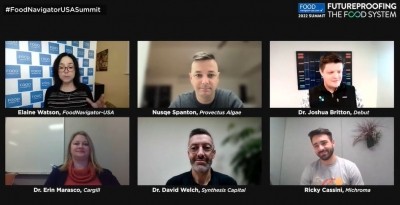If biomanufacturing is the next industrial revolution, what does that mean for food ingredients?

Find out November 15 in the opening session of our free-to-attend virtual summit, Futureproofing the Food System, which is broken down into six bite-sized c.90-105 minute sessions over three days: November 15-17.
The session, FOOD TECH IN FOCUS: Sustainable Sourcing for Colors, Flavors, and Sweeteners; and plotting a future for dairy… without cows (11am - 12.45pm Central time, Tues November 15) opens with a 50-minute panel on biosynthesis that will address questions such as:
- Fermentation capacity – how are bottlenecks being addressed?
- Why is bio-synthesis all the rage now? Is reading (sequencing) and writing (synthesizing) DNA rapidly just way cheaper and easier now?
- What’s the scope of fermentation for producing flavors, colors, sweeteners? Where does it make sense to extract natural flavors, colors, sweeteners and other food ingredients from plants vs microbial fermentation, ‘cell-free’ approaches, or plant cell culture?
- What’s the focus of firms in this space? To replace synthetic versions with natural versions (eg. vanillin)? To make natural ingredients more efficiently/sustainably/predictably (eg. Reb M)? To enable the commercialization of molecules in plants or animals not currently on the market because it wouldn’t make economic sense to extract them (eg. brazzein)? To create novel/designer ingredients?
- Can you replicate the complexity of plant extracts or animal products with synthetic biology?
- Which microbes will be the production workhorses in future and why?
- When it comes to efficiency, is it all about developing high-yielding strains, or is downstream processing and purification enabling the recovery of more of the target ingredient equally important?
- Will using cell-free approaches to bio-manufacturing allow for metabolic transformations that are not possible in cellular microbial fermentation systems?
- How does the GMO factor impact the precision fermentation space, and how might different production systems (eg. if the microbe expresses a target ingredient intracellularly or extracellularly) have a bearing on bioengineered labeling in the US?
- As precision fermentation gains traction, more attention is being paid to the source of feedstocks. Is it sustainable to divert food crops such as corn to make carbon sources for all these microbes?
FOOD TECH IN FOCUS: Sustainable Sourcing for Colors, Flavors, and Sweeteners; and plotting a future for dairy… without cows (11am- 12.45pm Central time, Tues November 15)
PANEL: Biosynthesis: Fermentation and the future of flavors, colors and sweeteners Does it always make sense to extract flavors, colors, sweeteners and other food ingredients from plants if you can produce them more efficiently - and more sustainably – via microbial fermentation, ‘cell-free’ approaches or plant cell culture?
- Dr Joshua Britton, founder and CEO, Debut Biotech
- Nusqe Spanton, founder and CEO, Provectus Algae
- Dr David Welch, CSO and co-founder, Synthesis Capital
- Ricky Cassini, CEO and co-founder, Michroma
- Dr Erin Marasco, global biology lead, Cargill
- MODERATOR: Elaine Watson, senior editor, FoodNavigator-USA
PANEL: Dairy 2.0: Plant-based milks now account for more than 15% of the fluid milk market, while plant-based cheese, creamers, yogurts and ice cream continue to gain traction. So where is the market going next, where’s the white space in the category, and what is the potential of a new wave of ‘animal-free dairy’ products made with real milk proteins and fats, minus the cows?
- Miyoko Schinner, founder and CEO, Miyoko’s Creamery
- Dave Ritterbush, CEO, Califia Farms
- Matt Gibson, co-founder and CEO, New Culture
- Sonia Huppert, global innovation marketing leader, re-imagine protein, IFF
- MODERATOR: Elaine Watson, senior editor, FoodNavigator-USA
To find out more about this FREE event, which is sponsored by EpiCor postbiotic (Cargill), IFF, Ingredion, Cargill, and FoodBytes! By Rabobank, Amano Enzyme, Evergrain (ABInBev), Spoonshot, and Exberry by GNT, and supported by Oat Vita, click on the links below:























